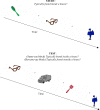The status of rapid response learning in aging
- PMID: 20853961
- PMCID: PMC3011028
- DOI: 10.1037/a0019430
The status of rapid response learning in aging
Abstract
Strong evidence exists for an age-related impairment in associative processing under intentional encoding and retrieval conditions, but the status of incidental associative processing has been less clear. In 2 experiments, we examined the effects of age on rapid response learning-the incidentally learned stimulus-response association that results in a reduction in priming when a learned response becomes inappropriate for a new task. Specifically, we tested whether priming was equivalently sensitive in both age groups to reversal of the task-specific decision cue. Experiment 1 showed that cue inversion reduced priming in both age groups with a speeded inside/outside classification task, and in Experiment 2, cue inversion eliminated priming on an associative version of this task. Thus, the ability to encode an association between a stimulus and its initial task-specific response appears to be preserved in aging. These findings provide an important example of a form of associative processing that is unimpaired in older adults.
(c) 2010 APA, all rights reserved).
Figures



Similar articles
-
Differential age effects for implicit and explicit conceptual associative memory.Psychol Aging. 2010 Dec;25(4):911-21. doi: 10.1037/a0019940. Psychol Aging. 2010. PMID: 21077717 Free PMC article.
-
Neural correlates of cue predictiveness during intentional and incidental associative learning: A time-frequency study.Int J Psychophysiol. 2019 Sep;143:80-87. doi: 10.1016/j.ijpsycho.2019.06.010. Epub 2019 Jun 27. Int J Psychophysiol. 2019. PMID: 31254544
-
The Associative Memory Deficit in Aging Is Related to Reduced Selectivity of Brain Activity during Encoding.J Cogn Neurosci. 2016 Sep;28(9):1331-44. doi: 10.1162/jocn_a_00970. Epub 2016 Apr 15. J Cogn Neurosci. 2016. PMID: 27082043 Free PMC article.
-
Aging and memory as discrimination: Influences of encoding specificity, cue overload, and prior knowledge.Psychol Aging. 2016 Nov;31(7):758-770. doi: 10.1037/pag0000126. Psychol Aging. 2016. PMID: 27831714 Free PMC article.
-
The effects of aging on the neural basis of implicit associative learning in a probabilistic triplets learning task.J Cogn Neurosci. 2012 Feb;24(2):451-63. doi: 10.1162/jocn_a_00116. Epub 2011 Aug 23. J Cogn Neurosci. 2012. PMID: 21861675 Free PMC article.
Cited by
-
Early response activation in repetition priming: an LRP study.Exp Brain Res. 2017 Oct;235(10):2927-2934. doi: 10.1007/s00221-017-5017-1. Epub 2017 Jul 12. Exp Brain Res. 2017. PMID: 28702835 Free PMC article.
-
Visual Acuity does not Moderate Effect Sizes of Higher-Level Cognitive Tasks.Exp Aging Res. 2016;42(3):221-63. doi: 10.1080/0361073X.2016.1156964. Exp Aging Res. 2016. PMID: 27070044 Free PMC article.
-
Study-test congruence of response levels in item stimulus-response priming.Mem Cognit. 2020 Jul;48(5):839-855. doi: 10.3758/s13421-020-01021-9. Mem Cognit. 2020. PMID: 32086755 Free PMC article.
-
Differential age effects for implicit and explicit conceptual associative memory.Psychol Aging. 2010 Dec;25(4):911-21. doi: 10.1037/a0019940. Psychol Aging. 2010. PMID: 21077717 Free PMC article.
-
Stimulus-response bindings in priming.Trends Cogn Sci. 2014 Jul;18(7):376-84. doi: 10.1016/j.tics.2014.03.004. Epub 2014 Apr 24. Trends Cogn Sci. 2014. PMID: 24768034 Free PMC article. Review.
References
-
- Allen PA, Coyne AC. Age differences in primary organization or processing variability Part I: An examination of age and primary organization. Experimental Aging Research. 1988;14(2-3):143–9. - PubMed
-
- Allen PA, Coyne AC. Are there age differences in chunking? Journal of Gerontology. 1989;44(6):181–3. - PubMed
-
- Allen PA, Crozier AC. Age and ideal chunk size. Journal of Gerontology. 1992;47(1):47–51. - PubMed
-
- Bastin C, Van der Linden M. The contribution of recollection and familiarity to recognition memory: A study of the effects of test format and aging. Neuropsychology. 2003;17:14–24. - PubMed
-
- Bowers JS, Schacter DL. Implicit memory and test awareness. Journal of Experimental Psychology: Learning, Memory and Cognition. 1990;3(16):404–416. - PubMed

